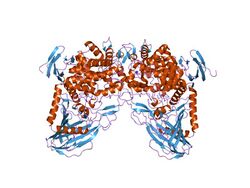Biology:Glycoside hydrolase family 65
| Glycosyl hydrolase family 65, N-terminal domain | |||||||||
|---|---|---|---|---|---|---|---|---|---|
 maltose phosphorylase from lactobacillus brevis | |||||||||
| Identifiers | |||||||||
| Symbol | Glyco_hydro_65N | ||||||||
| Pfam | PF03636 | ||||||||
| Pfam clan | CL0103 | ||||||||
| InterPro | IPR005196 | ||||||||
| SCOP2 | 1h54 / SCOPe / SUPFAM | ||||||||
| CAZy | GH65 | ||||||||
| |||||||||
| Glycosyl hydrolase family 65 central catalytic domain | |||||||||
|---|---|---|---|---|---|---|---|---|---|
 maltose phosphorylase from lactobacillus brevis | |||||||||
| Identifiers | |||||||||
| Symbol | Glyco_hydro_65m | ||||||||
| Pfam | PF03632 | ||||||||
| Pfam clan | CL0059 | ||||||||
| InterPro | IPR005195 | ||||||||
| SCOP2 | 1h54 / SCOPe / SUPFAM | ||||||||
| CAZy | GH65 | ||||||||
| |||||||||
| Glycosyl hydrolase family 65, C-terminal domain | |||||||||
|---|---|---|---|---|---|---|---|---|---|
 maltose phosphorylase from lactobacillus brevis | |||||||||
| Identifiers | |||||||||
| Symbol | Glyco_hydro_65C | ||||||||
| Pfam | PF03633 | ||||||||
| InterPro | IPR005194 | ||||||||
| SCOP2 | 1h54 / SCOPe / SUPFAM | ||||||||
| CAZy | GH65 | ||||||||
| |||||||||
In molecular biology, glycoside hydrolase family 65 is a family of glycoside hydrolases.
Glycoside hydrolases EC 3.2.1. are a widespread group of enzymes that hydrolyse the glycosidic bond between two or more carbohydrates, or between a carbohydrate and a non-carbohydrate moiety. A classification system for glycoside hydrolases, based on sequence similarity, has led to the definition of >100 different families.[1][2][3] This classification is available on the CAZy web site,[4][5] and also discussed at CAZypedia, an online encyclopedia of carbohydrate active enzymes.[6][7]
This family of glycosyl hydrolases (CAZY GH_65) includes vacuolar acid trehalase and maltose phosphorylases. Maltose phosphorylase (MP) is a dimeric enzyme that catalyzes the conversion of maltose and inorganic phosphate into beta-D-glucose-1-phosphate and glucose.
It consists of three structural domains. The C-terminal domain forms a two layered jelly roll motif. This domain is situated at the base of the catalytic domain, however its function remains unknown.[8] The central domain is the catalytic domain, which binds a phosphate ion that is proximal the highly conserved Glu. The arrangement of the phosphate and the glutamate is thought to cause nucleophilic attack on the anomeric carbon atom.[8] The catalytic domain also forms the majority of the dimerisation interface. The N-terminal domain is believed to be essential for catalytic activity[8] although its precise function remains unknown.
References
- ↑ "Conserved catalytic machinery and the prediction of a common fold for several families of glycosyl hydrolases". Proceedings of the National Academy of Sciences of the United States of America 92 (15): 7090–4. July 1995. doi:10.1073/pnas.92.15.7090. PMID 7624375. Bibcode: 1995PNAS...92.7090H.
- ↑ "Structures and mechanisms of glycosyl hydrolases". Structure 3 (9): 853–9. September 1995. doi:10.1016/S0969-2126(01)00220-9. PMID 8535779.
- ↑ "Updating the sequence-based classification of glycosyl hydrolases". The Biochemical Journal 316 (Pt 2): 695–6. June 1996. doi:10.1042/bj3160695. PMID 8687420.
- ↑ "Home" (in en). http://www.cazy.org/.
- ↑ "The carbohydrate-active enzymes database (CAZy) in 2013". Nucleic Acids Research 42 (Database issue): D490–5. January 2014. doi:10.1093/nar/gkt1178. PMID 24270786.
- ↑ "Glycoside Hydrolase Family 65" (in en). http://www.cazypedia.org/index.php/Glycoside_Hydrolase_Family_65.
- ↑ CAZypedia Consortium (December 2018). "Ten years of CAZypedia: a living encyclopedia of carbohydrate-active enzymes". Glycobiology 28 (1): 3–8. doi:10.1093/glycob/cwx089. PMID 29040563. https://hal.archives-ouvertes.fr/hal-01886461/file/Hehemann_2018_01.pdf.
- ↑ 8.0 8.1 8.2 "Crystal structure of maltose phosphorylase from Lactobacillus brevis: unexpected evolutionary relationship with glucoamylases". Structure 9 (8): 689–697. 2001. doi:10.1016/S0969-2126(01)00626-8. PMID 11587643.
 |

